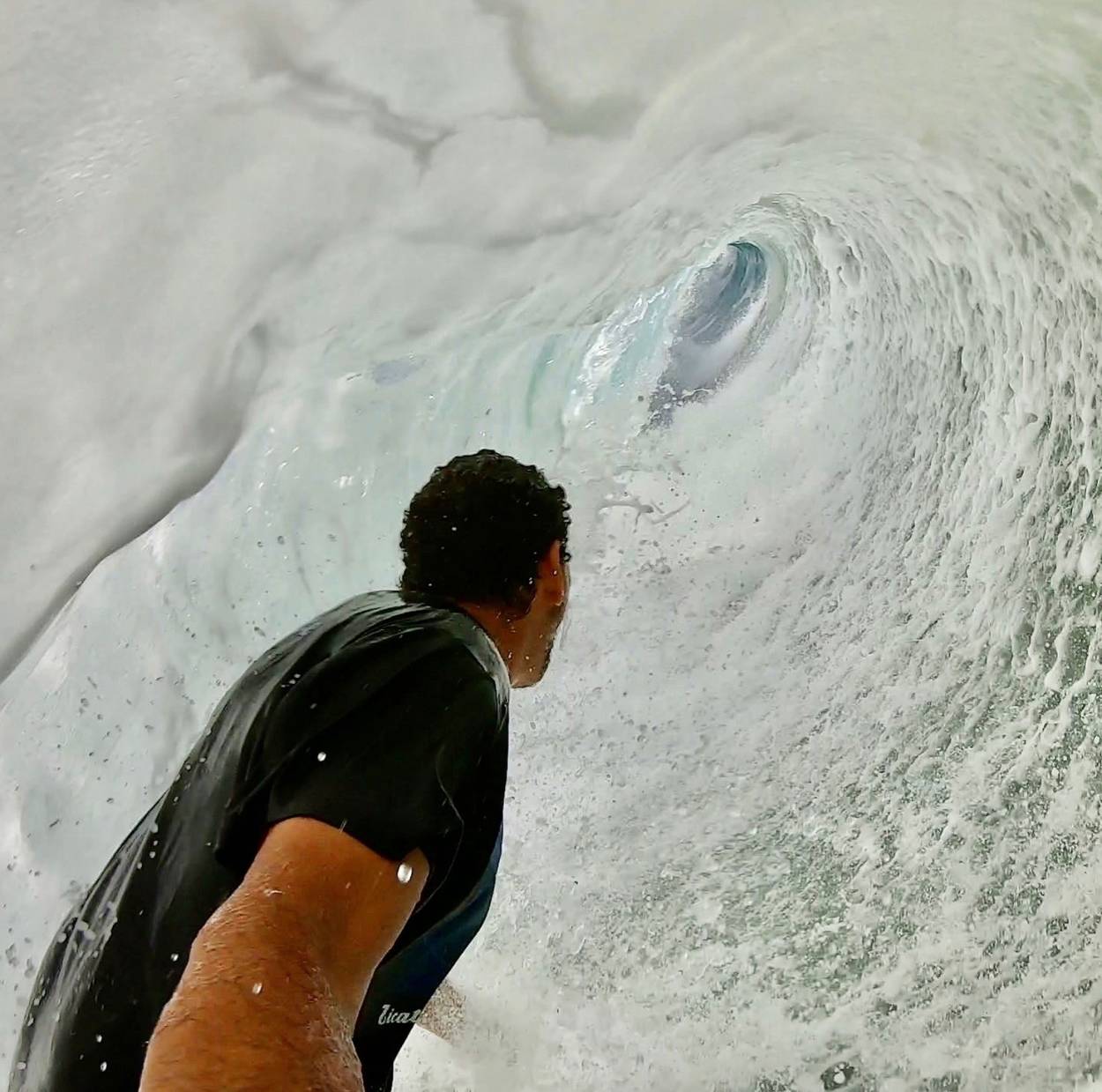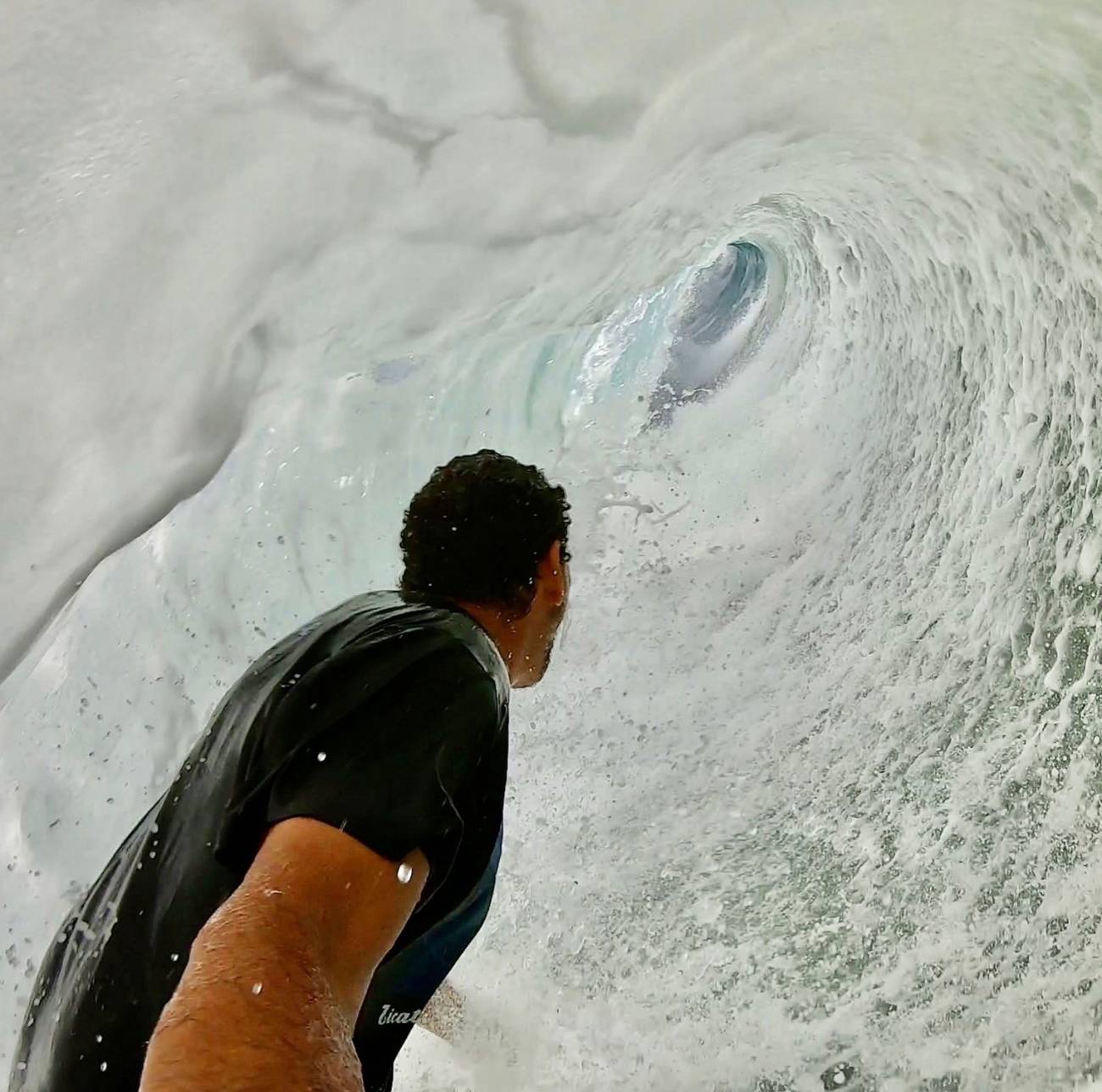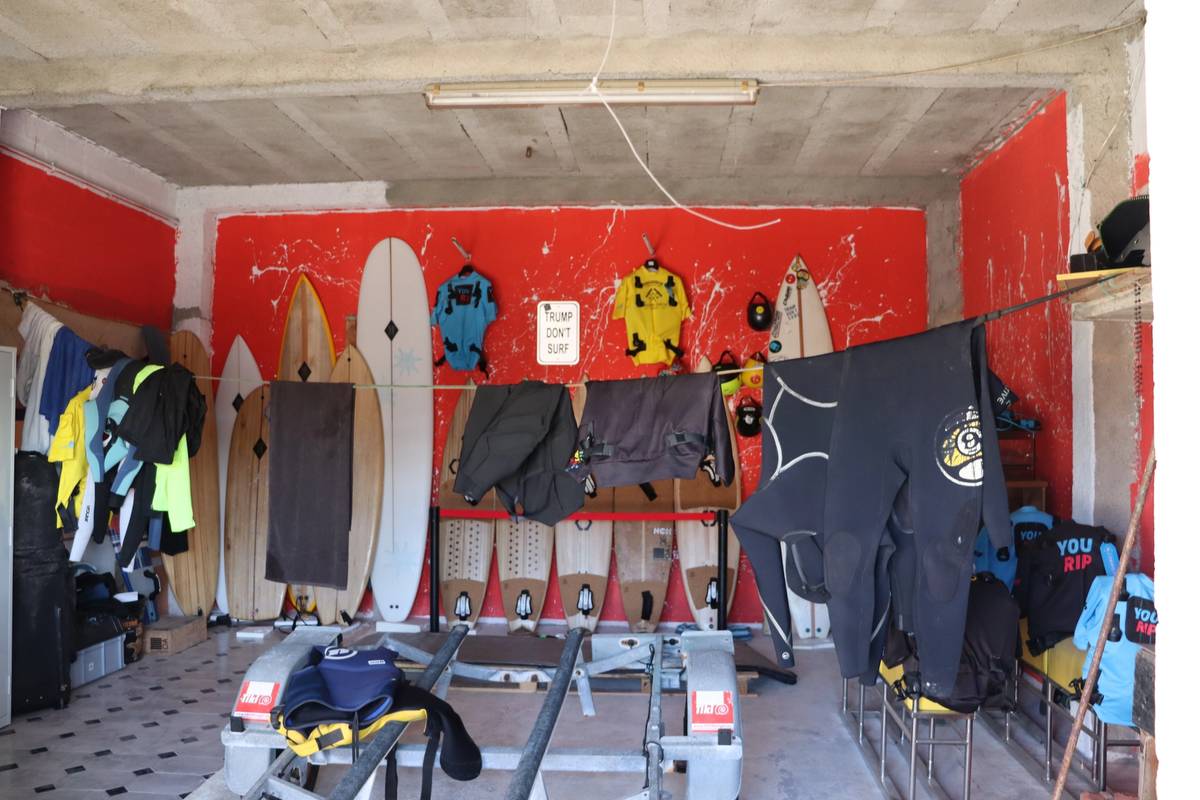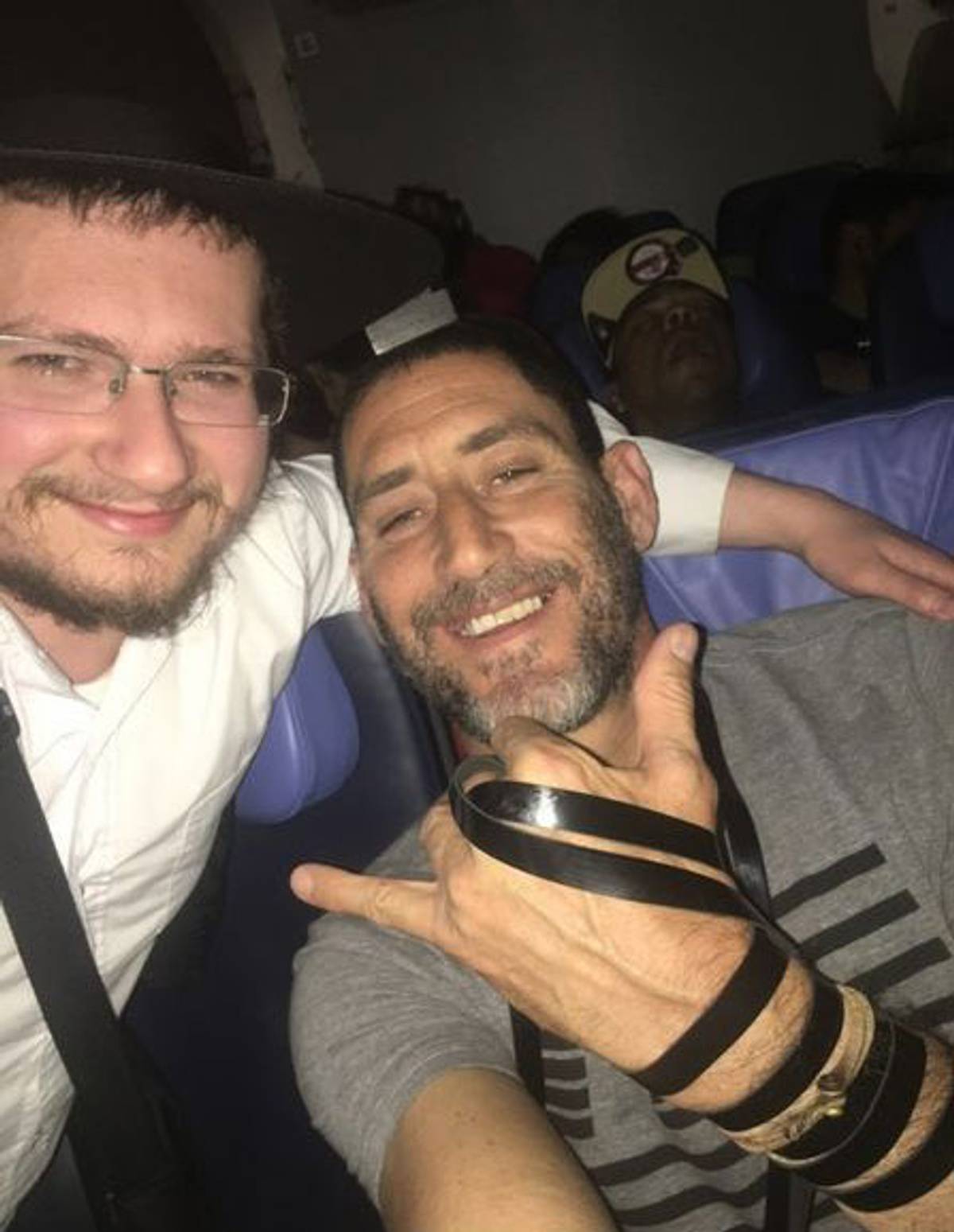David of Nazaré
Even after a Southern California upbringing, it took a Portuguese village with megawaves to bring David Langer’s love of surfing home




Surf towns can change the world. That, at least, is what David Langer believes.
“Mandela said, sport has the power to change the world. And if surfing is the best sport, and big wave surfing is the best thing we got, then Nazaré has the power to change the world.” Nazaré, a once-sleepy Portuguese fishing village, has transformed in recent years into a surfing mecca thanks to a unique geological formation offshore that creates some of the biggest waves on the planet. Its growing popularity is bringing everyone from ecotourists to aquatic enthusiasts to see the natural beauty of people riding waves the size of Manhattan apartment buildings.
But David arrived in Nazaré before the adoring crowds came. Standing at 6-foot-4, Langer is reminiscent of Charlton Heston on a surfboard, with a tightly cropped Jewfro and a graying beard atop massive hulking shoulders. Born in Southern California in the 1970s, his early years were stereotypically SoCal: just beautiful weather, sports, getting into trouble, and, of course, girls.
“My father was the typical Jewish mother,” Langer playfully noted of his childhood days. Where his mother was carefree, his father was risk-averse. Fearful that a broken surfboard or mountain bike crash was too dangerous for his son, David’s dad, Peter, held a soft spot for baseball and pined for his son to take up the game.
Born in 1931, Peter fled Nazism in Austria alongside his mother and sister. His father, Heinrich, was caught by the Nazis and imprisoned. Although Heinrich managed to escape and made his way to Chicago, he forever carried with him the physical and emotional scars of the Holocaust. Much of Peter’s childhood revolved around caring for his father, so he never had the freedom to play baseball himself.
As with most bootstrapping Holocaust survivors, Peter “carved himself a little niche in the world,” David recalls. He went to Northwestern and “brought his family to a place where they weren’t stressed out about running or building a life back after running,” David remembers. If sports like baseball were his calling, David says, his dad’s attitude was “so be it”: so long as he got an education, too.
Surfing proved to be difficult to square with his father’s wishes, though. With “surfing sometimes you gotta miss school,” David joked. “Sometimes the waves are too good, especially in Southern California where they don’t get good all the time. If you really love it, you can’t think of anything but going and getting waves.”
But not all was idyllic about David’s ’70s California upbringing. His parents divorced when he was 16. “The reins loosened once they had problems,” David said. “Their problems became my freedom. When they divorced, I was superfree. Like buck-wild.” David ended up falling in with the wrong crowd. Drugs and alcohol were never far away. He soon developed a cocaine addiction which he battled throughout his late teens and earlier 20s.
A good friend had been to the North Shore of Oahu and told him he had to check it out. “It wasn’t sort of. It was very definitive,” David recalls of kicking his addiction. “I found that I didn’t need cocaine over there. I didn’t want it. I was challenged.” But returning to California weeks later, David fell back into his old habit. He yo-yoed for the next year until he went back to Hawaii, got clean, then fell off the wagon again back in California.
“Woah, I’m going to die soon,” David realized when he looked at himself in the mirror during this time. Luckily, his father, who could sometimes be naive toward hardships like this, supported him through his battle with addiction and offered to send David to rehab. “I was like, no, I need to move to the North Shore. I won’t do it on the North Shore.” Although it wasn’t his first choice, Peter went along with it.
David soon turned his life around. He became a vegetarian, went to college, and immersed himself in Hawaiian surf culture. Life was finally turning around. But that all changed when his father was diagnosed with chronic fatigue syndrome. The compounding of unresolved Holocaust trauma, former marital problems, and a second wife uninterested in caring for him, “brought him to his knees, where he was done,” David believes. Fearful that he was going to deteriorate like his mother, Peter asked David “to call Kevorkian” if he were ever put on machines.
At 23, David didn’t fully process what his dad was implying. The diagnosis was nonfatal and only in retrospect did David understand his father’s wishes when Peter committed suicide the following day. “When that happened, I couldn’t go on with this love for being behind a desk like he had,” David confided. He dropped out of college and transferred into photography school. When I asked David to imagine how his life would’ve looked if his father were still alive, he said, “If he were still around today, I’d probably be a corporate lawyer. I would have definitely stayed the course. I would have kept on trying to impress him. I was so proud of my A’s in school.”
Peter’s death provoked David to reconsider his father’s life and his own journey. He now saw in Peter’s success the suffocating pain of a corporate straitjacket. Whereas Peter could never bring himself to quit, David never wanted to be boxed in. Free from the well-meaning yet domineering yoke of fatherly love, David went soul searching.
Initially he approached this new chapter in his life with a professional mindset. “So how was I going to make money doing what I love? I suppose the question is I had an opportunity to really chase after what I loved, which was to be outdoors.”
David soon found himself making a living and competing as a professional downhill mountain biker. But he couldn’t shake the nagging sense that something else was missing; the call of the ocean was never far from mind. Years later he still remembers the “key moment” after one mountain biking race outside of Waimea Bay, the famed Hawaiian surf spot known for breaks as Pipeline. Hanging out afterward “at the back of a truck with all these biking pros” the group saw surfers dropping in on “20-, 30-foot waves.” One of the bikers spoke up as David retells it. “And he’s like, ‘Man, I wish I could do that.’ And I just talked to myself. ‘I can!’ Like, what am I doing with these guys? That is a really special thing, and I can do that.”
His timing couldn’t have been better. The early ‘90s in Hawaii were a revolutionary moment in the big wave surfing world. “For years, big wave surfing was stuck on a plateau,” Alexander Haro writes. “Up until the early 1990s, waves larger than somewhere around the 20-foot mark were, for the most part, thought of as simply too big to surf. That seemed to be the range where Mother Nature was too strong to overcome—human paddle power just wasn’t enough, and waves that big were deemed ‘impossible’ to surf.” Spearheaded by Laird Hamilton, surfers were beginning to use jet skis to break the barrier and ride once-unsurfable waves.

After a bad mountain biking injury that left David with an atrophied shoulder muscle, on the mend and unable to paddle into bigger waves, David bought himself a jet ski. “That changed my life.” Big waves presented taller surfers like David, much like the 6-foot-3 Laird, with a “better fit” rather than “crunching down” on smaller faces.
For David, chasing enormous waves quickly became his “cue to keep going.” Is he ever freaking out before standing up on one of those waves? “You can’t think about that stuff, because if you hesitate for one second, you’re going to eat it,” David said nonchalantly. “We can’t be thinking, ‘Oh, I might not make it.’ Cause you won’t.”
For David, the thrill always crowded out the fear and, inevitably, Nazaré came calling. As rumors of megawaves slowly made their way through the surf community, David packed up and flew to Portugal to check it out firsthand. “So I got here and just went, ‘Oh, my God.’ This is the Shangri-La of big waves surfing. The waves come all the time. They’re bigger and better than the ones that I just came from.” It wasn’t simply that Nazaré had the gnarliest waves but that “people can watch from right there!”
Jutting out like a thumb in the eye of the Atlantic Ocean, the medieval fortress turned a lighthouse turned big wave surf museum now serves as the gathering place for fans to catch the best views. The famous foreground has attracted thousands of tourists to Nazaré, which has gained a reputation for treating surfers as part of their extended family. “The municipality rolls out the red carpet for us,” David cheerily said as our conversation drifted through the foggy morning hours in a café atop the old Portuguese town of Sitio, north of Nazaré.
David was right that surfers were treated like local celebrities. Breaking up our rounds of coffee and tea, as townspeople filtered in for their morning reinforcement, without fail, David would go over and greet them. The middle-aged balding barista, the old ladies bundled up in their traditional sete saias (seven skirts), the American retirees, an Italian surfer. Through broken Portuguese David would kibitz and smile, hug and shake hands.
Of course, no man is an island, and helping David survive the surf gantlet is a posse of friends and characters that make him one of Nazaré’s unique treasures. A December swell brought one of David’s sponsors and friends, Rainer Jaeger, a Belgian kite-surfing musician turned Portuguese hemp farmer, to check out the waves. After towing the viral YouTube surfer Ben Gravy into some amazing waves, David raced his jet ski toward the choppy white water festering along shore, dropped off Ben, and quickly picked up Rainer. Standing ankle-deep in the rough yellow sand on Praia do Norte, the north beach where the megawaves break, his board shaper, Christian Delfs, served as a nautical tour guide pointing out the breaks, changing conditions, and wave size in real time. Christian’s steely demeanor stood out against the bizarre spectacle unfolding just yards away in the Atlantic where a handful of jet ski teams were scouring for the best waves.
Christian was a late arrival to the world of board-making. Having decided to quit a steady job, the middle-aged Bavarian dipped into his savings to make environmentally friendly surfboards. While most people his age are counting down to retirement, Christian, fresh off a divorce, was living out of a converted camper van looking for adventure. He had made his way from Munich, sleeping and surfing throughout the voyage in his workshop on wheels appropriately emblazoned with his company logo, Bav Boards, for everyone in Sitio to see.
Huddled within this milieu of personalities and passion, for nearly a decade Nazaré has served as David’s winter surf oasis. And while many of the surfers feel blessed to be a part of the town’s new history, buried beneath its natural beauty is the inescapable reality that for the select few who tempt fate, it can be a life-or-death situation. David learned this in 2018 while towing Brazilian surfer Thiago Jacaré. Wearing his signature neon yellow vest, David dropped Thiago into a massive wave only for him to tumble off as the crashing wave behind him caught up. Rushing in, David struggled to spot him. Battered by four massive waves, Thiago was eventually rescued by another rescue jet ski and only narrowly escaped death.

For all the craziness, David is one of the lucky ones. Despite the injuries and close calls, he doesn’t look in the rearview mirror and contemplate what might have been; what the 9-to-5er version of his life could have looked like. “I can’t afford the luxury of a negative thought,” he waxed near the end of our early morning coffee that had run well into the afternoon. It’s worked out well for him. A few years back, David was inducted into the de facto big wave surf Hall of Fame nestled in the celebrated cliffside lighthouse. There, alongside the legends of big wave surfing—Garrett McNamara, Rodrigo Koxa, Maya Gabeira, Andrew Cotton—David’s signature board and neon vest proudly adorn the 500-year-old rugged stone walls.
Like most surfers living off the good grace of Mother Nature, David’s journey has humbled him. Riding waves in Newport Beach years earlier, he remembers being overwhelmed by a set of oncoming waves. “It was one after the other, after the other, after the other and I just thought, ‘Oh my God, how am I going to make it under each one of these waves and not die?’ So, I prayed to God, let me get through this and I’ll be good. We all know that prayer because the ocean will do that to you.”
As he tells it, David’s spirituality is a blend of being “agnostic” with “Judaism running through his blood,” a nod to Albert Einstein’s own complex relationship to God. His childhood in Orange County “was pretty sheltered,” David confesses, “even sheltered from Judaism.” His dad’s wishes of assimilating into the American fold led to David celebrating a mixture of Jewish holidays alongside Christmas and Easter growing up. It remained there, a background ambiance that never quite faded. In his 30s, thanks to the encouragement from a local rabbi in Oahu, he got bar mitzvahed, learned how to wrap tefillin, and was given his first mezuzah.
David still keeps the traditions alive. Visiting him during peak surf season last December, I had the opportunity to light Hanukkah candles with David. Living within walking distance from Sitio’s old cobblestone public square, I descended into David’s cavernous walkout apartment, the sun setting into the horizon. Snaking through the narrow entranceway, I turned left down the stairs into a tight kitchen. The smell of freshly cooked miso soup bubbled in the background. Lacking the proper candles, David used oversized white Shabbat candles to fill the menorah. While he—as well as I—struggled to find the right words, the Jewish spirit was alive and well that night. True to tradition, halfway across the world in a remote fishing village on the edge of Portugal, David welcomed a stranger with kindness. He would have given the shirt off his back or, better yet, his wetsuit.
Ari David Blaff is a journalist based in Toronto and writer at Deseret. His writing has appeared in Quillette, National Review, and The Globe & Mail.